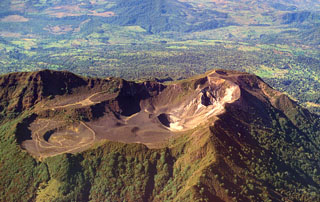Report on Turrialba (Costa Rica) — 1 October-7 October 2008
Smithsonian Institution / US Geological Survey
Weekly Volcanic Activity Report, 1 October-7 October 2008
Managing Editor: Sally Sennert.
Please cite this report as:
Global Volcanism Program, 2008. Report on Turrialba (Costa Rica) (Sennert, S, ed.). Weekly Volcanic Activity Report, 1 October-7 October 2008. Smithsonian Institution and US Geological Survey.
Turrialba
Costa Rica
10.025°N, 83.767°W; summit elev. 3340 m
All times are local (unless otherwise noted)
According to news articles, access to Turrialba Volcano National Park was closed on 30 September because the S and SE winds, typical for the time of year, were blowing toxic gases to the area of the park where visitors enter and view the volcano.
Geological Summary. Turrialba, the easternmost of Costa Rica's Holocene volcanoes, is a large vegetated basaltic-to-dacitic stratovolcano located across a broad saddle NE of Irazú volcano overlooking the city of Cartago. The massive edifice covers an area of 500 km2. Three well-defined craters occur at the upper SW end of a broad 800 x 2200 m summit depression that is breached to the NE. Most activity originated from the summit vent complex, but two pyroclastic cones are located on the SW flank. Five major explosive eruptions have occurred during the past 3500 years. A series of explosive eruptions during the 19th century were sometimes accompanied by pyroclastic flows. Fumarolic activity continues at the central and SW summit craters.
Source: La Nacion

